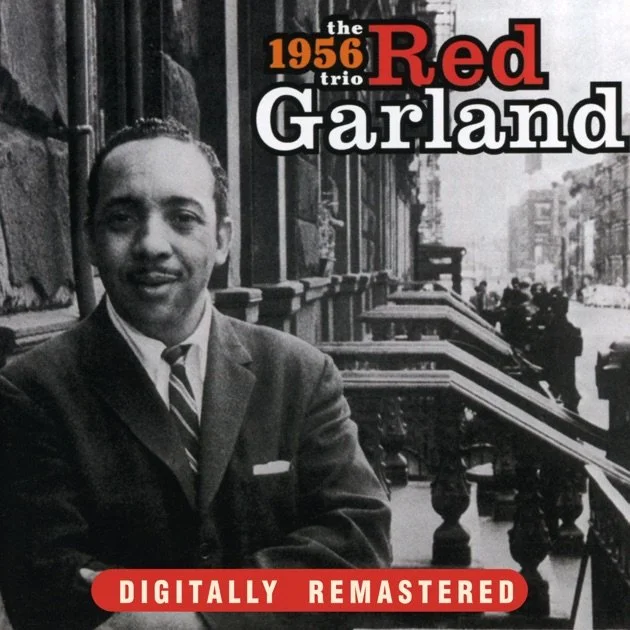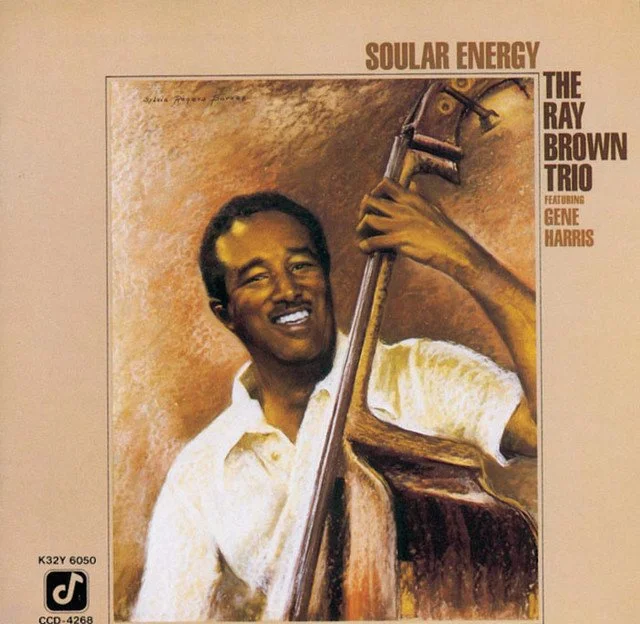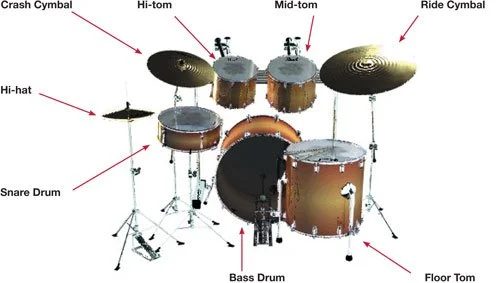The Trio
The jazz trio—piano, bass, drums—is pretty much the foundation of the music. There is no rule that you can't make music with smaller or different arrangements: piano-bass duos; guitar trios, and of course solo performances. But the piano trio arrangement is very common, and it usually forms the backbone of larger ensembles, which we'll talk about later. But for now, let's look at how a trio works.
PIANO
In a trio setting a piano is really two instruments. The right hand--the higher notes--generally plays melody lines, whether the melodies are the original song or part of the pianist's improvised solo. The left hand--the lower notes--are usually concerned with the harmonies of a song. In other settings, the piano can fill different roles. Playing solo, in the old "stride piano" style, the left hand plays both bass notes and chords, alternating in a kind of "oom-pah" feeling. The right hand is free to play melodies in the higher notes. (Listen to track ? on the “Trio” playlist.
Some solo pianists will play a "walking bass" part with the left hand, creating that driving rhythm and giving the right hand responsibility for both harmony and melody. (Listen to track ? on the “Trio” playlist.)
But in a trio, with a bass and drums establishing a steady pulse, the pianist is free to be rhythmically creative. She can be spare or maximalist, laid-back or aggressive, play with the established pulse or against it. It's a part of the pianist's personal signature and style.
Count Basie, most famous for his big bands, was also an elegant pianist who believed that less is more. Listen to the charming way he plinks and plonks against the steady beat of his drummer (Louis Bellson) and bassist (Ray Brown) in “(Un) Easy Does It.”
Basie's style is distinctive in its economy, the way he sparingly defines the harmonies. Red Garland’s trio playing is more traditional, establishing the harmonies with left-hand chords and playing the melody with the right hand. Listen to Garland play "What Is This Thing Called Love?" with his trio (Paul Chambers, bass and Art Taylor, drums).
Garland launches right into the melody with the walking bass and drums keeping time. At 0:36, the drums and bass drop out for a few beats as he makes the transition into the improvised solo section. In the solo, you continue to hear his right hand dancing through his improvisation, but listen closely and you can hear him drop in chords softly here and there (musicians call this "comping"). When the bass takes a solo (1:45-2:55), he continues to softly “comp” to articulate the harmonies of the song.
Following the bass solo, the trio then "trades fours," a way to allow a drummer a chance to solo. The pianist--or another soloist--will play four bars (or measures) and then drop out to let the drummer play the next four bars by himself. The group will repeat this back and forth until it's time for the next solo or to go back to the "head" (main melody of the song).
BASS
An acoustic bass is shaped like a violin, but it's much, much larger. That means the notes are much, much lower. Unlike a violin, which is usually played with a bow, creating long, sustained notes, a bass is mostly "plucked" when it plays jazz. As you can imagine, that allows the bass to contribute to the rhythm of a song.
In addition to securing the beat, the bass also fills an important harmonic function. Since it's way down at the low end of the pitch spectrum, a bass often articulates the key note of a chord--the "root." In any kind of music--orchestral symphonies or piano sonatas, folk ballads or church hymns--the root is the important anchor of a harmony. And since that's the bass's stomping ground, it’s all about the roots.
That doesn't mean that a bassist is just thumping on the roots of the chords as they parade by. Good bassists know how to move through a harmonic progression that makes it clear and solid, but they add their own inventive touch. On a ballad--a song with a slow tempo--a bassist might define the harmony as usual, but occasionally add a flourish during the quiet spots between musical phrases (drummers do this, too).
Listen to the way Paul Chambers accompanies Red Garland when he plays the melody of "Makin' Whoopee." When Garland is playing the melody, he plays some notes solidly on the beat. But also adds flourishes along the way, adding some interest but not interfering with the melody.
In tunes with a faster tempo, the bass often “walks,” playing even “one-to-the-beat” notes that serve to propel the music as well as articulate the harmonies.
The skill here is to smoothly “walk” between the notes that root the harmony of each chord change. If you listen closely you’ll hear a good bassist create tension and then resolve it by moving away from the “root” and then landing on it. Listen to a few examples at different tempos and hear how the bass drives the rhythm as well as establishing the harmonic base. One of the masters of the bass, Ray Brown, is known for his keen sense of rhythm. In “Exactly Like You,” he starts off playing, but then drives the rhythm as pianist Gene Harris plays the melody. But when Harris starts his solo (0:48), Brown announced with a bit THWAP, that he’s ready to drive the song forward with a steady walk. After Harris’s solo, the trio trades fours giving Brown and drummer Gerryck King a chance to take some short solos.
DRUMS
Drum sets are pretty ubiquitous in pop and rock music, and a a jazz drum set is a similar animal, a collection of percussion instruments rather than a single one. Typically--at a minimum--a drum set will consist of a bass drum, a high hat, a snare drum, a ride cymbal (or two) and one or two “toms.” The bass is played with a foot pedal, and typically keeps a consistent, even beat in a song. On a high hat, two cymbals are attached to a pole that allows the drummer's foot to move them together or apart.
The snare drum is a relatively high pitched drum that usually sits right in the drummer's lap. Usually, a "snare" sits on the bottom surface of the drum head, giving the drum a buzzy sound. Drummers can lift it away from the skin of the drum with a lever, which removes the buzz and give the drum a tighter, "tuned" sound.
Toms (think "tom-tom") either sit on the floor or are attached to the bass drum to form a kind of arrangement that makes it easy for the drummer to have access to all the instruments. They are "tuned" and have distinctive sounds but aren't necessarily tuned to a specific pitch (like a timpani in an orchestra).
A ride cymbal (or two) is suspended about the drums. It's a single metal disk that can delicately articulate a steady rhythm (example) or smashed for dramatic emphasis.
Jazz drummers usually play with the familiar wooden sticks, but will also use metal brushes (that can be swirled over a snare drum) on quiet songs. And when the end of a song calls for a climax, they will use mallets--not hammers, but sticks which have soft balls of yarn on the end—to make a shimmery whoosh.
All the instruments in a trio share a tight sense of the rhythm of the song. But the drum is the anchor since it rarely plays "out of time." If you listen closely, you'll usually hear a drummer keep a steady, repetitive pattern that sets the tempo of the song. But a creative drummer will also interact with the other musicians with "chatter"--subtle accents that mark the end of phrases or fill in little breaks in the melody.
So that’s the trio. The next time you listen to a tune, keep your ears on the various instruments and listen how they play their parts, and how they perhaps stretch past their conventional roles. Jazz, after all, is always about the push-pull between tradition and innovation.








